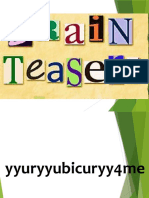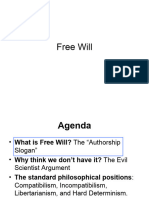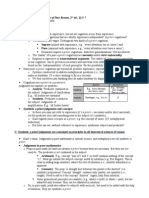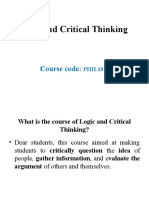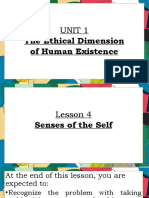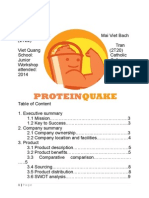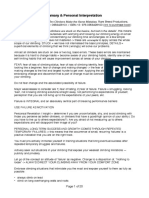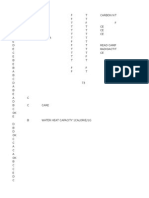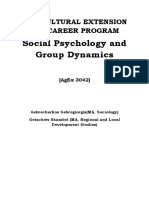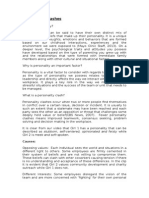Professional Documents
Culture Documents
Seminar 10 Kant On The Resolution of The Antinomies
Uploaded by
Viet Quang Tran0 ratings0% found this document useful (0 votes)
17 views24 pagesOriginal Title
Seminar 10 Kant on the Resolution of the Antinomies
Copyright
© © All Rights Reserved
Available Formats
PPTX, PDF, TXT or read online from Scribd
Share this document
Did you find this document useful?
Is this content inappropriate?
Report this DocumentCopyright:
© All Rights Reserved
Available Formats
Download as PPTX, PDF, TXT or read online from Scribd
0 ratings0% found this document useful (0 votes)
17 views24 pagesSeminar 10 Kant On The Resolution of The Antinomies
Uploaded by
Viet Quang TranCopyright:
© All Rights Reserved
Available Formats
Download as PPTX, PDF, TXT or read online from Scribd
You are on page 1of 24
Kant on the Resolution of
the Antinomy (PH 3261)
Dr. Qu Hsueh Ming (phiqhm@nus.edu.sg)
Road Map for the General Solution to the
Antinomies
• Section 5: ‘Skeptical representation’ of the conflicts of the
antinomies.
• Section 6: Distinguish transcendental idealism from empirical
idealism; discusses existence.
• Section 7: Sketches the general form of the resolution.
• Section 8: Explains the principles of Kant’s resolution.
Section 5: Starting to Solve the Problem
• Cosmological Idea of the World-Whole either too big or too small.
• First three antinomies:
• Thesis is too small (limited world whole)
• Antithesis too big (infinite regress)
• Fourth antinomy:
• Thesis too big (absolutely necessary being)
• Antithesis too small (insufficient grounding for what exists)
• Both thesis and antithesis are non-sensical.
• Examine a common presupposition that both make, and question it.
• Common presupposition = idea of the world-whole.
Section 6: Existence
• Kant’s point: what is it for something to exist? In what sense is it
impossible for the unconditioned condition to not exist?
• For something to exist is for it to be given in intuition, or related to an
intuition according to the laws of nature.
• The unconditioned condition cannot exist because it cannot even exist in the
progress of possible experience.
Section 7: General Solution
• Antinomies can be represented as a syllogism:
• 1) If the conditioned is given, then the whole series of all conditions for it is
also given;
• 2) Objects of the senses are given as conditioned;
• 3) Therefore, the whole series of conditions for objects of the senses are
given (as either finite or infinite).
General form of the solution
• Point is that the thesis and antithesis are not exhaustive: there is
another option.
• Kant’s example: everyone smells good, everyone smells not good.
General form of the solution
• Point is that the thesis and antithesis are not exhaustive: there is
another option.
• Kant’s example: everyone smells good, everyone smells not good.
Better example
• (1) All dogs are not cute, vs. (2) All dogs are cute
Better example
• (1) The dog is not cute, vs. (2) The dog is cute
•
Better example
• (1) The dog is not cute, vs. (2) The dog is cute
Antinomies proving TI
• If the world was a thing-in-itself, the set of conditions for it (the
world-whole) would be either finite or infinite.
• Since the set of conditions for it is neither, the world cannot be a
thing-in-itself.
• Thus, the world must be an appearance.
Section 8: Regulative and Constitutive
• Reason’s idea of the unconditioned is only regulative rather than
constitutive.
• Antinomies err in going from the rule of always looking for a further
condition, to asserting that there is a totality of conditions (the world-
whole).
Freedom and Determinism (Specific
Solution)
• The issue of the world-whole is an illegitimate question. But the issue
of freedom can still be raised independently of it.
• Transcendental realism leaves no room for rescuing transcendental
freedom.
Solving the Issue of
Freedom and Determinism
Two perspectives
• A subject can be considered with respect to:
• Empirical character
• Intelligible character.
Empirical Character
• Wholly determined.
• Power of choice of empirical character: capacity to choose (subject to
determinism) between possible actions.
• Animals’ power of choice are sensibly necessited.
• Humans’ power of choice are sensibly affected, but not necessitated.
Intelligible character
• Beyond time, and thus beyond causality.
• Intelligible character determined by intellectual laws.
Freedom
• Freedom and determinism can thus be found in the same action,
depending on whether we view the subject according to empirical or
intelligible character.
• Us humans can be considered both as appearances and things-in-
themselves.
• Appearances: inner sense, empirical character
• Things-in-themselves: via TUA. Suggests something more than empirical, but
does not tell us anything about our intelligible character.
Transcendental Cause
• Ourselves, via pure reason.
• Pure Reason does not yield to any empirically given ground, and so is
independent of causal determination.
Reason
• Empirical Character = power of choice, purely physiological
• Practical reason = non-empirical faculty of reason as applied to action.
Pure Reason
• Purely intelligible, and beyond appearances.
• ‘In regard to the intelligible character, of which the empirical one is only the
sensible schema, no before or after applies, and every action, irrespective of
the temporal relation in which it stands to other appearances, is the
immediate effect of the intelligible character of pure reason…’ (A553/B581)
• Reason has its own interest and goals.
• Speculative goals (Theoretical Reason): to find an absolutely unconditioned
condition.
• Practical goals (Practical Reason): to find reasons that are absolutely
unconditional (categorical imperatives).
The Malicious Lie
• We can explain a malicious lie completely through empirical causes.
• Yet we still blame the agent!
• Hume: thus moral blame is not sensitive to transcendental freedom.
• Kant: thus we must view the agent as having transcendental freedom!
A Trilemma
• Our moral practices are generally true and meaningful
• For our moral practices to be generally true and meaningful, there
must be Transcendental Freedom
• There is no Transcendental Freedom.
Versions of the thesis and antithesis being
true
• Modified Thesis: In the intelligible ground of the existence of the
appearance there may be a ground of existence whose causality is
free (self-determining).
• Modified Antithesis: within the series of appearances we should
never stop in the search for a further cause.
You might also like
- A Seminar On MetaphysicsDocument26 pagesA Seminar On MetaphysicsMark Anthony DacelaNo ratings yet
- 2 Importance and Evaluation of WorldviewsDocument34 pages2 Importance and Evaluation of Worldviewsaz62033284No ratings yet
- Philosophy 1.1 Methods of PhilosophizingDocument4 pagesPhilosophy 1.1 Methods of PhilosophizingAizel Joyce DomingoNo ratings yet
- Lesson 15 Approaches To Moral ReasoningDocument41 pagesLesson 15 Approaches To Moral ReasoningItsClarenceNo ratings yet
- PHIL 1110 Introduction to Philosophy 哲學概論: Chong-Fuk Lau November 26, 2020Document10 pagesPHIL 1110 Introduction to Philosophy 哲學概論: Chong-Fuk Lau November 26, 2020MelodyLoNo ratings yet
- Utilitariansm, Hedonism, Consequentialism & AltruismDocument11 pagesUtilitariansm, Hedonism, Consequentialism & AltruismPantatNyanehBurikNo ratings yet
- LESSON 2 (Existentialism and Postmodernism)Document46 pagesLESSON 2 (Existentialism and Postmodernism)marc aries cametNo ratings yet
- Introduction To Philosophy Study GuideDocument9 pagesIntroduction To Philosophy Study Guide2340gp100% (1)
- Lectures 3 To 8 Trolley Problem and Ethics, Utilitarianism and DeontologyDocument27 pagesLectures 3 To 8 Trolley Problem and Ethics, Utilitarianism and DeontologysidNo ratings yet
- CH 2Document53 pagesCH 2Getahun AbebawNo ratings yet
- Senses of The Self & Moral DevelopmentDocument23 pagesSenses of The Self & Moral DevelopmentEARL GERALD RICAFRANCANo ratings yet
- FreeWill ShortDocument74 pagesFreeWill ShorthenryzrNo ratings yet
- 3 Varieties of CategoricalDocument23 pages3 Varieties of CategoricalJelyn SustiguerNo ratings yet
- Deontological Ethics: Group 2Document18 pagesDeontological Ethics: Group 2Kent Clark VillaNo ratings yet
- Immanuel Kant (1724-1804) : Little Kant Pontificating To The ThrongDocument22 pagesImmanuel Kant (1724-1804) : Little Kant Pontificating To The ThrongtrnddpattyNo ratings yet
- Theories and Values Systems: Part 3 Chapter 2Document17 pagesTheories and Values Systems: Part 3 Chapter 2Jason WongNo ratings yet
- GEC107 ReviewerDocument6 pagesGEC107 Reviewerhelenmae.potestadNo ratings yet
- Deontological TheoryDocument53 pagesDeontological TheoryGabriel Panganiban100% (1)
- Deontological TheoryDocument53 pagesDeontological Theory10- SANTOS, MAJA JHAMIE C.No ratings yet
- Approaches in Doing PhilosophyDocument13 pagesApproaches in Doing PhilosophyViansie VinaraoNo ratings yet
- Freedom of Will and DeterminismDocument11 pagesFreedom of Will and DeterminismTanya MiyaNo ratings yet
- 8 DeontologyDocument22 pages8 DeontologyLorelene RomeroNo ratings yet
- Kant Cvsp203, Fall 2015Document23 pagesKant Cvsp203, Fall 2015Kat GuptaNo ratings yet
- 5a-Theory of FormalismDocument47 pages5a-Theory of FormalismDarwin EugenioNo ratings yet
- Deontological Theory Chapter 4Document22 pagesDeontological Theory Chapter 4minniestNo ratings yet
- ETHICSDocument63 pagesETHICSChiharu Jane Alegado100% (1)
- By: Ms. Josille MarquezDocument24 pagesBy: Ms. Josille MarquezJohn Paul RamosNo ratings yet
- Ethical TheoriesDocument42 pagesEthical TheoriesAlyssa DalawampuNo ratings yet
- 2 Philo of Human Person IntroductionDocument51 pages2 Philo of Human Person IntroductionJohaina PiangNo ratings yet
- Regional Training For Senior High School Teachers: UNP, Vigan City May 15-17,2016Document51 pagesRegional Training For Senior High School Teachers: UNP, Vigan City May 15-17,2016Jhon dave SurbanoNo ratings yet
- Theories of SubjectivityDocument18 pagesTheories of SubjectivityBill MeachamNo ratings yet
- MGX3100 Session 2 2018Document31 pagesMGX3100 Session 2 2018PutriNo ratings yet
- Lesson 2 Methods of PhiloosphizingDocument27 pagesLesson 2 Methods of PhiloosphizingLorraine Mae RobridoNo ratings yet
- Notes On The Introduction To Kant's First CritiqueDocument5 pagesNotes On The Introduction To Kant's First CritiqueJonathan SozekNo ratings yet
- Immanuel Kant-1Document30 pagesImmanuel Kant-1jin50% (2)
- 2 Ways of Doing PhilosophyDocument28 pages2 Ways of Doing Philosophyfelize padlla100% (2)
- Logic Notes PowerpointDocument101 pagesLogic Notes Powerpointjh342703No ratings yet
- Health Care Ethics 59 129 3Document76 pagesHealth Care Ethics 59 129 3Michaela De GuzmanNo ratings yet
- Cog Dev Lect 2Document10 pagesCog Dev Lect 2Audrey D. ChatmanNo ratings yet
- Logic ThinkingDocument33 pagesLogic ThinkingNaebel -No ratings yet
- Immanuel KantDocument4 pagesImmanuel KantJhecyl Ann BasagreNo ratings yet
- 2.utilitarianism and EmotivismDocument33 pages2.utilitarianism and EmotivismMuneer HussainNo ratings yet
- Ethical Theories and PrinciplesDocument71 pagesEthical Theories and PrinciplesAlyssa ErminoNo ratings yet
- Critical Short NotesDocument139 pagesCritical Short NotesEyasu demsewNo ratings yet
- Unit I - Lesson 5Document20 pagesUnit I - Lesson 5Michael Peralta MahinayNo ratings yet
- Lecture 9: Freedom and Choices: Duty andDocument22 pagesLecture 9: Freedom and Choices: Duty andphils_skoreaNo ratings yet
- The Legacy of Ancient Greek PhilosophyDocument36 pagesThe Legacy of Ancient Greek PhilosophyEvelinaNo ratings yet
- Ethics (4) (2)Document49 pagesEthics (4) (2)May May MagluyanNo ratings yet
- Four Theories of Normative EthicsDocument5 pagesFour Theories of Normative EthicsKolokoy KasinNo ratings yet
- Philosophy and Nature of Science: Part 1. Philosophy Part 2. PhilosophersDocument132 pagesPhilosophy and Nature of Science: Part 1. Philosophy Part 2. PhilosophersNorman IskandarNo ratings yet
- Business Ethics and SCR CH 2Document26 pagesBusiness Ethics and SCR CH 2Tesfayé HailuNo ratings yet
- Ethics C1Document19 pagesEthics C1Cristina AlDoileaContNo ratings yet
- Deontological TheoryDocument53 pagesDeontological TheoryCATHLEENE MAYNE BELIRANNo ratings yet
- Global Ethics Week 6 Summary Lecture 1 2024Document83 pagesGlobal Ethics Week 6 Summary Lecture 1 2024zhengsiyuan26No ratings yet
- Deontology: Respect For PersonsDocument58 pagesDeontology: Respect For PersonsKimberly FieldsNo ratings yet
- Unit II: Foundations of The Principles of EthicsDocument59 pagesUnit II: Foundations of The Principles of EthicsBernise CeredonNo ratings yet
- Understanding The SelfDocument32 pagesUnderstanding The SelfAnonymous 0TdrHbNo ratings yet
- Seminar 9 Kant On Freedom The Third AntinomyDocument17 pagesSeminar 9 Kant On Freedom The Third AntinomyViet Quang TranNo ratings yet
- Kant Second EssayDocument11 pagesKant Second EssayViet Quang TranNo ratings yet
- Shopee Python-Pandas Test (45 Mins)Document3 pagesShopee Python-Pandas Test (45 Mins)Viet Quang Tran100% (3)
- Cpsa Crest Revision 1) Core Technical Skills: IGRP - Interior Gateway Routing ProtocolDocument64 pagesCpsa Crest Revision 1) Core Technical Skills: IGRP - Interior Gateway Routing ProtocolViet Quang TranNo ratings yet
- Blank Adoption Contract (Updated 3 Nov 2020)Document4 pagesBlank Adoption Contract (Updated 3 Nov 2020)Viet Quang TranNo ratings yet
- Tranvietquang ReportDocument4 pagesTranvietquang ReportViet Quang TranNo ratings yet
- Gray Hat Hacking The Ethical Hacker's Handbook 5th EditionDocument577 pagesGray Hat Hacking The Ethical Hacker's Handbook 5th EditionLuis Zavala Villanueva87% (31)
- Code of Conduct Individual v15 yAzqO4eDocument30 pagesCode of Conduct Individual v15 yAzqO4eViet Quang TranNo ratings yet
- Seminar 8 The ParalogismsDocument15 pagesSeminar 8 The ParalogismsViet Quang TranNo ratings yet
- Business Plan Final 1Document22 pagesBusiness Plan Final 1Viet Quang TranNo ratings yet
- Climbing Notes - Summary & Personal Interpretation: Page of 1 20Document20 pagesClimbing Notes - Summary & Personal Interpretation: Page of 1 20Viet Quang TranNo ratings yet
- Business Plan Final 2Document22 pagesBusiness Plan Final 2Viet Quang TranNo ratings yet
- Financial Plan 2.0Document8 pagesFinancial Plan 2.0Viet Quang TranNo ratings yet
- Quick Pitch ToolsDocument14 pagesQuick Pitch ToolsViet Quang TranNo ratings yet
- Salt (C)Document17 pagesSalt (C)Viet Quang TranNo ratings yet
- CHEM3Document4 pagesCHEM3Viet Quang TranNo ratings yet
- Quick Pitch ToolsDocument14 pagesQuick Pitch ToolsViet Quang TranNo ratings yet
- 1KDocument8 pages1KManav GaneshNo ratings yet
- Oxidation and ReductionDocument12 pagesOxidation and ReductionViet Quang TranNo ratings yet
- Stronger Unpacked Felicity To of MistakenDocument2 pagesStronger Unpacked Felicity To of MistakenPineapple HeadNo ratings yet
- Business Studies - 2 Chapter 8Document9 pagesBusiness Studies - 2 Chapter 8Vipin Mandyam KadubiNo ratings yet
- HandOuts For John of SalisburyDocument3 pagesHandOuts For John of SalisburyMelchizedek Beton OmandamNo ratings yet
- Copyreading and Headline Writing Elementary: Code Final Score RankDocument2 pagesCopyreading and Headline Writing Elementary: Code Final Score RankReggieReyFajardoNo ratings yet
- Module 2 Asking Good Questions Empathy Confrontation Hand OutDocument62 pagesModule 2 Asking Good Questions Empathy Confrontation Hand OutReilpeterNo ratings yet
- Transformational Leadership and OrganizaDocument16 pagesTransformational Leadership and OrganizameuscursossotiNo ratings yet
- Legend Hotel Case DigestDocument2 pagesLegend Hotel Case DigestKian Fajardo100% (1)
- ET Module Final Draft Social Psychology & Group DynamicsDocument216 pagesET Module Final Draft Social Psychology & Group DynamicsAschale Gessie WorasheNo ratings yet
- Assignment Bbun2103 May 2016Document14 pagesAssignment Bbun2103 May 2016qaiyumhamid100% (1)
- CHANGE Management REPORT - Institute of Management Sciences, PakistanDocument27 pagesCHANGE Management REPORT - Institute of Management Sciences, Pakistanmian zufiqar100% (3)
- Monster Unit AssessmentDocument4 pagesMonster Unit AssessmentLatacha HardnettNo ratings yet
- Rodriguez Vs Manila Rail RoadDocument3 pagesRodriguez Vs Manila Rail RoadChristelle Ayn BaldosNo ratings yet
- What Is Forgiveness - Jay E. Adams PDFDocument48 pagesWhat Is Forgiveness - Jay E. Adams PDFJessonDiazVicenteNo ratings yet
- Four Noble TruthsDocument35 pagesFour Noble Truthssati100% (1)
- Magna Carta and NZ ConstitutionDocument22 pagesMagna Carta and NZ ConstitutionSimon KaiwaiNo ratings yet
- Petition For BailDocument2 pagesPetition For BailxiadfreakyNo ratings yet
- Personality ClashesDocument4 pagesPersonality ClashesKyle L PillayNo ratings yet
- Project LawDocument72 pagesProject LawKapildev DhakaNo ratings yet
- Critical ReadingDocument2 pagesCritical ReadingEdi Galih SantosoNo ratings yet
- COT LarpDocument78 pagesCOT LarpRebebeNo ratings yet
- An Inspector Calls Tasks and Answers Crofton AcademyDocument34 pagesAn Inspector Calls Tasks and Answers Crofton AcademyelezabethNo ratings yet
- Legal MethodDocument23 pagesLegal Methodnayan96.mdgrNo ratings yet
- Professionalism & Ethics Module Spec - v2Document9 pagesProfessionalism & Ethics Module Spec - v2homsomNo ratings yet
- Business, Societal, and Ethical Contexts of Law - Week 2Document5 pagesBusiness, Societal, and Ethical Contexts of Law - Week 2Paulyn BathanNo ratings yet
- American Phrenological Journal (1848)Document24 pagesAmerican Phrenological Journal (1848)Arturo OrbegosoNo ratings yet
- DatanomicsDocument3 pagesDatanomicsOscar JaraNo ratings yet
- 09 Some Problems of Comparative PhilosophyDocument5 pages09 Some Problems of Comparative PhilosophyGediminas GiedraitisNo ratings yet
- Introduction To Urban Design and Community PlanningDocument8 pagesIntroduction To Urban Design and Community PlanningKevin ClaudioNo ratings yet
- Catherine Emmerick La Amarga Pasion de CristoDocument11 pagesCatherine Emmerick La Amarga Pasion de CristoAlejandro CastellerNo ratings yet
- AAA Journal Volume 26 Issue 5 2013 - Mainstreaming Biodiversity Accounting - Potential ImplicationsDocument28 pagesAAA Journal Volume 26 Issue 5 2013 - Mainstreaming Biodiversity Accounting - Potential ImplicationsKSatria BerGitarNo ratings yet






